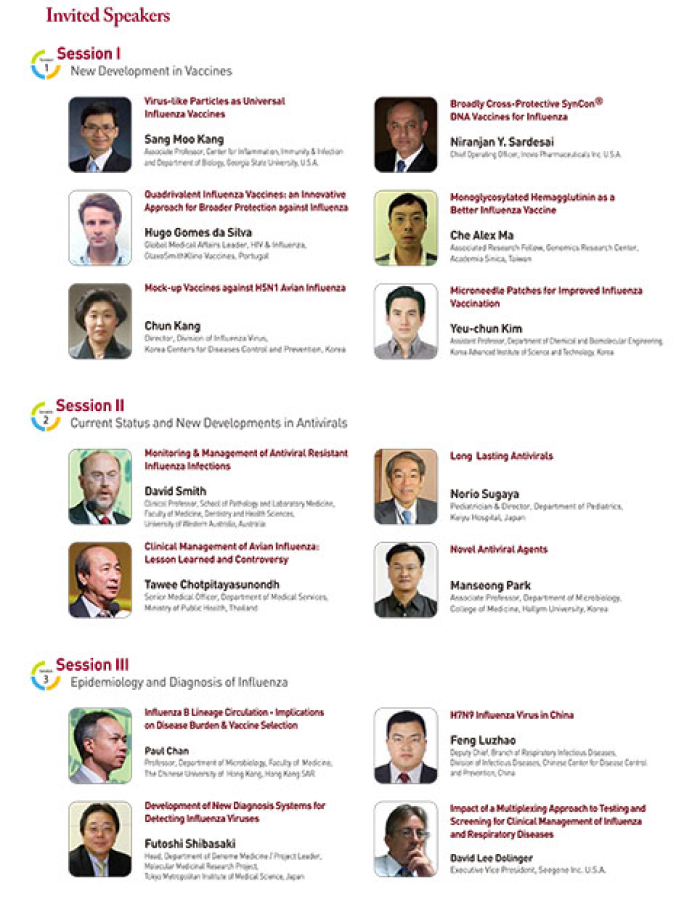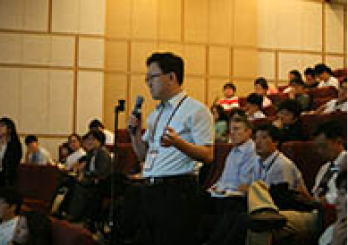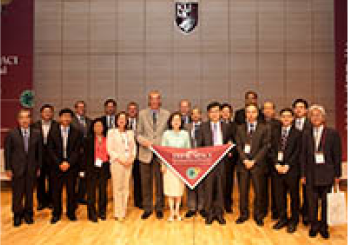The 2013 TEPIK/APACI International Influenza Symposium was held in Seoul, South Korea on 12 July 2013. Over 250 delegates from 15 countries attended the meeting.
We have listed here the abstracts from the Symposium.
Session 1 – New Developments in Vaccines
- Professor Sang-Moo Kang. Virus-like Particles as Universal Influenza Vaccines.
- Dr Bruce Innis. Inactivated Quadrivalent Influenza Vaccines: an Innovative Approach for Broader Protection against Influenza.
- Dr Gyu-jin Woo. Pre-pandemic Vaccine against H5N1 Avian Influenza.
- Dr Amir Khan. Broadly Cross-Protective SynCon® DNA Vaccines for Influenza.
- Dr Che Alex Ma. Monoglycosylated Hemagglutinin as a better Influenza Vaccine.
- Dr Yeu-chun Kim. Microneedle Patches for Improving Vaccination.
Session II – Current Status and New Developments in Antivirals
- Clinical Professor David Smith. Monitoring and Management of Antiviral Resistant Influenza Infections.
- Dr Tawee Chotpitayasunondh. Clinical Management of Avian Influenza: Lesson Learned and Controversy
- Dr Norio Sugaya. Long-lasting Neuraminidase Inhibitors
- Associate Professor Manseong Park. Novel Antiviral Agents.
Session III – Epidemiology and Diagnosis of Influenza
- Professor Paul Chan. Influenza B Lineage Circulation – Implications on Disease Burden and Vaccine Selection.
- Dr Futoshi Shibasaki. Development of New Diagnosis Systems for Detecting Influenza Viruses.
- Dr Feng Luzhao. H7N9 Influenza Virus In China.
- Dr David Lee Dolinger. Impact of a Multiplexing Approach to Testing and Screening for Clinical Management of Influenza and Respiratory Diseases.
2013 TEPIK/APACI International Influenza Symposium
Session I – New Developments in Vaccines
Virus-like Particles as Universal Influenza Vaccines

Professor Sang-Moo Kang.
Center for Inflammation, Immunity and Infection, and Department of Biology, Georgia State University, USA
Current influenza vaccines based on the hemagglutinin protein are strain specific and do not provide good protection against drifted viruses or emergence of new pandemic strains. Development of an influenza vaccine that provides broadly cross protective immunity has been a scientific challenge for over half a century. An influenza vaccine that can confer cross-protection against influenza A strains with antigenically differences is highly desirable for improving public
health. Virus-like particles (VLPs) can be produced in cell cultures by a self-assembly process using recombinant genetic engineering technology. VLPs composed of multimeric protein complexes with or without lipid bilayer membranes are similar to virus in structure and morphology, but lack the viral genome potentially permitting safer vaccine candidates. We found that viral vaccine antigens that are presented on VLPs were hundred fold higher immunogenic and capable of conferring effective protection even in the absence of adjuvants compared to the same protein antigens in a soluble form.
To develop a cross protective vaccine, we generated influenza VLPs containing the highly conserved M2 protein in a membrane-anchored form, and investigated their immunogenicity and breadth of protection. A tandem repeat of M2e epitope sequences (M2e5x) of human, swine, and avian origin influenza A viruses, which was genetically engineered and expressed on VLPs (M2e5x VLPs), provided a wide range of protection against H1, 2009 H1N1 pandemic, H3, and H5 influenza viruses. In addition, M2e5x VLPs were found to be a stronger inducer of M2 immunity than live influenza A viruses.
We found a strategy to overcome the strain-specific protection of current human seasonal vaccines by implementing a new concept of supplementation with M2e5x VLP vaccine. Human split vaccines supplemented with M2e5x VLPs were highly effective in improving the breadth of cross protection compared to the split vaccine alone. In studies of protective immune mechanisms, Fc receptors, alveolar macrophages and dendritic cells were found to play a criticla role in providing M2 immune mediated protection. The results further provide evidence that developing universal influenza vaccines would be feasible with advancing VLP vaccine technology.
Broadly Cross-Protective SynCon® DNA Vaccines for Influenza

Dr Amir Khan.
Director of Product Development, Inovio Pharmaceuticals Inc., USA
The recent avian, H1N1 and H7N9 influenza outbreaks highlight the inherent limitations of traditional egg-based influenza vaccines. The time required for the generation of an effective vaccine using this platform is on the order of months after the isolation of a newly emergent influenza variant and the single-strain specificity of these vaccines narrows their ability to be effective against other viral strains.The DNA platform allows for the propagation of viral antigens in a rapid,
high-throughput system cutting the development time of a potential vaccine down to weeks instead of months as well as allowing for the use of synthetic consensus antigens designed to possess the ability to neutralize more than a single strain of influenza. This presentation will discuss novel technologies using broadly neutralizing, synthetic consensus (SynCon®)DNA vaccines that may help to overcome the constraints of current influenza vaccine development, including data from clinical trials demonstrating a 78-89% antibody response rate to our SynCon® H5 avian influenza vaccine, seroconversion against 9 distinct H1N1 viruses in response to our SynCon® H1 influenza vaccine and preclinical data highlighting the rapid response to the H7N9 outbreak culminating in 100% of vaccinated animals showing protective antibody titers in an HAI assay.
Inactivated Quadrivalent Influenza Vaccines: an Innovative Approach for Broader Protection against Influenza

Dr Bruce Innis.
Global Clinical Research and Development Leader, Influenza Vaccines, GlaxoSmithKline, (USA)
Two antigenically distinct lineages of influenza B virus have circulated globally since 1987. However, licensed seasonal trivalent influenza vaccines (TIVs) contain antigens from only a single influenza B virus and thus provide limited immunity against circulating influenza B strains of the lineage absent from the vaccine. In recent years, predictions about which B lineage will predominate in an upcoming influenza season have been no better than chance alone,
reducing their effectiveness against influenza B. However, seasonal influenza vaccines could be improved by inclusion of influenza B strains of both lineages. The resulting quadrivalent influenza vaccines (QIVs) would allow influenza vaccination campaigns to respond more effectively to current global influenza epidemiology. Manufacturing capacity for seasonal influenza vaccines has increased sufficiently to supply QIVs, and methods to identify the influenza B strains to include in such vaccines are in place. Several manufacturers of inactivated influenza vaccines, including GlaxoSmithKline Vaccines, have performed clinical studies of QIVs. Studies in which more than 9,300 subjects 6 months and older received GSK’s QIVs in controlled trials have demonstrated that, compared with TIVs, the QIVs produce equivalent immune responses to the three common strains, superior immune responses to the additional B lineage, and they do not compromise the reactogenicity and safety profile. These data provide confidence that QIV represents an innovation that is expected to increase protection against influenza B, a potentially serious and life-threatening illness for persons of all ages.
Monoglycosylated Hemagglutinin as a better Influenza Vaccine

Dr Che Alex Ma.
Associate Research Fellow, Geonomics Research Center, Academia Sinica, Taiwan
Influenza pandemics occur when the viral surface glycoprotein hemagglutinins (HA) are little or not recognized by immunity and the viruses transmit efficiently from human to human. HA binds to specific sialylated glycan receptors in the respiratory tract allowing the virus to enter the cell, and has been recognized as the key antigen in the host immune response to influenza virus in both natural infection and vaccination. We have previously shown that H5N1 HA with N-
acetylglucosamine (GlcNAc) at each N-glycosylation sites (monoglycosylated HA, HAmg) as a protein vaccine increased the antibody response and neutralization activity as compared to the fully glycosylated HA (HAfg). We also examined the cross reactivity and protective immunity of antibodies elicited by vaccination of H1N1 HA, with various degrees of glycosylations, toward various influenza A (H1N1) viruses. The HAmg vaccine elicited anti-HA antibodies with higher hemagglutination inhibition, microneutralization activity and resulted in a better survival rate in virus challenge experiments than HAfg. The protein vaccines of HAmg designed from pandemic influenza A/California/07/2009 and seasonal influenza A/Brisbane/59/2007 are both sufficient to provide cross-protection against infections with the highly pathogenic H1N1 viruses in mice; similar broadening immune response from HAmg vaccination can also be observed in ferrets. This study provides new insights into the origin of cross reactivity and protective immunity provided by monoglycosylated viral surface glycoproteins and reveals a general strategy for vaccine design against human viruses.
1. Chen JR, Ma C* Wong CH* (2011). Vaccine design of hemagglutinin glycoprotein against influenza. Trends in Biotechnology, 29, 426-434.
2. Wang CC, Chen JR, Tseng YC, Hsu CH, Hung YF, Chen SW, Chen CM, Khoo KH, Cheng TJ, Cheng YSE, Jan JT, Wu CY, Ma C* Wong CH* (2009). Glycans on influenza hemagglutinin affect receptor binding and immune response. Proc. Natl. Acad. Sci. U. S. A. 106, 18137-18142.
Pre-pandemic Vaccine against H5N1 Avian Influenza
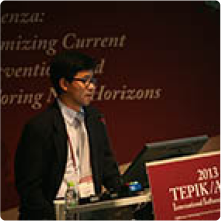
Dr Gyu-jin Woo.
Chief Scientist, Vaccine Team, Mogam Biotechnology Research Institute, South Korea
Since the first human infection with highly pathogenic avian influenza A (H5N1) virus was reported in 1997, influenza A viruses (H5N1) have caused wide spread infections that have resulted in severe disease or death in poultry and wild birds as well as in human beings. Therefore, we are developing the pre-pandemic H5N1 influenza vaccine for pandemic preparedness with a reference strain NIBRG-14, generated by reverse genetics (RG) from A/Vietnam/1194/ 2004.
To prepare an effective vaccine, we established the egg based production processes and verified the vaccine efficacy and safety in non-clinical test. Two-dose regimen of inactivated whole-virion influenza A vaccine with alum adjuvant, MG1109, induced immune responses that effectively neutralized the H5N1 virus. We knew that the serum from the immunized animals had cross-reactivity to H5N1 virus strain of a different clade.
Clinical trial was performed and assessed the dose-response, safety and efficacy in a blind study of 346 healthy volunteers. Phase I trial was performed to evaluate the safety of MG1109 in 40 healthy adults that were randomly assigned to 4 cohorts (3.75, 7.5, 15, 30 ㎍ HA/dose) of 10 subjects each. Phase II clinical trial was performed in 306 healthy adults that were randomly assigned to 2 cohorts (15, 30 ㎍ HA/dose) of 153 subjects each. There was no MG1109 related serious adverse reaction. The results of Heamagglutination inhibition assay were accepted the efficacy criteria in Seroconversion rate (SCR), Seroprotection rate (SPR) and Geometric Mean ratio (GMR).
Based upon these results, now we are preparing the phase III clinical trial. If we completed the development successfully, MG1109 will be used for pre-pandemic vaccine in H5N1 influenza pandemic situation.
Microneedle Patches for Improving Vaccination

Dr Yeu-chun Kim.
Assistant Professor, Department of Chemical and Biomolecular Engineering, Korea Advanced Institute of Science and Technology, South Korea
Influenza is a vaccine-preventable disease, but remains a major health problem world-wide. Morbidity and mortality due to influenza could be reduced by development of simple and effective vaccination methods. Immunization via the skin is attractive, because, in large part, the skin is replete with antigen-presenting cells such as Langerhans and dermal
dendritic cells. Arrays of metal micron-scale needles were coated with influenza inactivated virus vaccines suitable for simple, manual application. A single dose of influenza vaccine from microneedles (MNs) generated strong antibody and cellular immune responses in mice and provided superior protection against lethal viral challenge at the main site of viral replication in the lung, as evidenced by virus clearance below the detection limit. Additionally, microneedle vaccination resulted in enhanced cellular recall responses after challenge.
In contrast to conventional egg-based vaccine production, cell-based vaccines are being developed to expedite vaccine manufacturing and thereby reduce the threat of insufficient supply. Virus like particles (VLPs) and DNA vaccines are attractive cellbased vaccines and the vaccinations using MN patch coated with VLP or DNA demonstrated dose-sparing effects of influenza vaccine in comparison with intramuscular (IM) injection.
Apart from immunologic advantages, microneedles also offer potential logistic opportunities. The small size of microneedles should facilitate storage, stockpiling and transportation of influenza vaccines. Vaccination should be faster and simpler because microneedles are painless and suitable for self administration. Mass-produced microneedles would be cost-competitive with hypodermic needle and syringe.
In summary, our results suggest that influenza vaccine delivery to the skin using microneedle patches may provide a new modality to increase patient coverage and improve immunogenicity of influenza and other vaccines.
Session II – Current Status and New Developments in Antivirals
Monitoring and Management of Antiviral Resistant Influenza Infections.
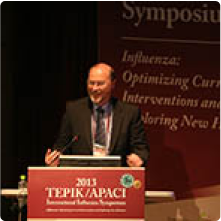
Clinical Professor David Smith.
PathWest Laboratory Medicine WA; and the School of Biomedical, Biomolecular and Chemical Sciences and the School of Pathology and Laboratory Medicine, University of Western Australia
There are a limited number of antiviral agents that are available for the treatment and prevention of influenza. The adamantanes (amantadine and rimantadine) are no longer recommended as first-choice drugs for either the treatment or prevention of influenza due to widespread resistance. Therefore the mainstay of antiviral therapy for
influenza currently is the neuraminidase inhibitors, particularly oseltamivir and zanamivir. Generally resistance to these antivirals has been uncommon, though widespread resistance to oseltamivir (OST) due to the H275Y mutation developed in the pre-2009 seasonal A/H1N1 viruses. While that strain was replaced by the OST-susceptible H1N1 2009 virus, influenza A/H1N1 viruses continue to show sporadic resistance to OST with limited transmission within the community. Furthermore other mutations within the gene may increase OST-resistance and/or confer resistance to other neuraminidase inhibitors. However resistance to zanamivir remains rare, as is OST- resistance in A/H3N2 and influenza B viruses.
There is a need to continue monitoring antiviral susceptibility in influenza viruses worldwide due to the ongoing potential for resistant virus to emerge. This is particularly important in patients on prolonged treatment, especially immunocompromised patients. At our laboratory we have used a mutant specific real-time PCR for detection of H275Y variants in community and hospital samples over 3 years. We have detected the mutation in only 2/254 (0.8%) of samples coming from community and outpatient samples, compared with 6/135 (4.5%) of hospital and mortuary samples. Hospitals should have protocols in place for regular testing of upper and lower respiratory tract samples from high risk patients and for the treatment of patients who are infected with resistant viruses, including the use of intravenous therapy in severely ill patients. The development of new neuraminidase inhibitors, as well as other antiviral therapies and immunomodulators, should improve the options for managing these patients.
Key references
01
Renaud C et al. Emerging oseltamivir resistance in seasonal and pandemic influenza A/H1N1. J Clin Virol. 2011 Oct;52(2):70-8.
02
Chidlow GR et al. The detection of oseltamivir-resistant pandemic influenza A/H1N1 2009 viruses using a real-time RT-PCR assay. J Virol Methods. 2010 Oct;169(1):47-51
03
Hurt AC et al. Increased detection in Australia and Singapore of a novel influenza A(H1N1)2009 variant with reduced oseltamivir and zanamivir sensitivity due to a S247N neuraminidase mutation. Euro Surveill. 2011 Jun 9;16(23). doi:pii: 19884.
04
Leang SK et al. Influenza antiviral resistance in the Asia-Pacific region during 2011. Antiviral Res. 2013 Feb;97(2):206-10.
05
Hayden FG. Newer influenza antivirals, biotherapeutics and combinations. Influenza and Other Respiratory Viruses 7(Suppl. 1), 63–75.
Long-lasting Neuraminidase Inhibitors
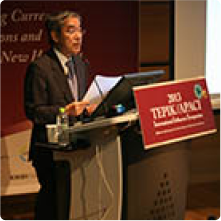
Dr Norio Sugaya.
Pediatrician and Director, Department of Pediatrics, Keiyu Hospital, Japan
Since the approval of zanamivir and oseltamivir for use in influenza virus infection in Japan in 2000, rapid diagnostic tests have been routinely performed by clinicians in patients who exhibit an influenza-like illness, and patients with positive test results, including otherwise healthy adults and children without any underlying illness, have usually been treated with neuraminidase inhibitors (NAIs). Even though 20.7 million cases of pandemic H1N1/09 infection were
reported in Japan during the 2009-2010 season, only 198 deaths were reported nationwide. The very low mortality rate that resulted from the H1N1/09 epidemic in Japan was mainly attributable to the universal implementation of early treatment with NAIs since the year 2000. In addition to oseltamivir and zanamivir, the recently approved inhaled drug laninamivir and intravenous drug peramivir were used in Japan since the 2010-2011 season, bringing to four, the total number of NAIs currently being used in hospitals and clinics nationwide. The most important characteristic of laninamivir or peramivir is its long-lasting antiviral activity. The Japanese Association for Infectious Diseases recommends that influenza patients who have been hospitalized, especially patients with pneumonia, be treated with oseltamivir or peramivir. Intravenous peramivir may be the best option for the treatment of severe influenza virus infection. On the other hand, use of inhaled laninamivir has sharply increased in Japan because of much better compliance than oseltamivir or zanamivir.
Clinical Management of Avian Influenza: Lesson Learned and Controversy

Dr Tawee Chotpitayasunondh,
Senior Medical Officer, Department of Medical Services, Ministry of Public Health, Senior Medical Officer, Queen Sirikit National Institute of Child Health, Thailand
Avian influenza (AI) is generally mean influenza virus A subtypes that primarily affect poultry, migratory waterfowl, and others. Most of these viruses usually do not causes disease in humans or other mammals but in some instances these viruses have also reported to cross species barrier to infect them. AI viruses are classified into two groups based on their
ability to cause disease in poultry; high pathogenicity (HPAI) and low pathogenicity (LPAI). HPAI usually result severe and high fatal outcome in some poultry species while LPAI also can cause outbreak in birds but generally associated with mild or asymptomatic disease among them.Avian influenza A/H5N1 in human was first recognized in 1997 in Hong Kong SAR. The disease in poultry and human re-emergence in 2003, this avian virus had spread from parts of Asia to northeast Africa and has become endemic in some countries, resulting 630 human cases with 375 deaths (as of 4 June 2013). Scientists are concerning A/H5N1 virus have highly potential to mutate into more transmissible among human and pose potential of pandemic threats to global public health.
The clinical disease caused by A/H5N1 virus usually aggressive, rapid deterioration especially severe pneumonia or multiorgan failure resulting high fatality rate. Antiviral agents (neuraminidase inhibitors eg. oseltamivir, zanamivir) therapy is very essential and should be prescribed as soon as possible within 48 hours after the onset of illness to maximize their therapeutic benefits but also be considered in patients with later presentation. Limitation of oseltamivir is the only oral formulation available. In severely ill H5N1 patient or patient whom had severe gastrointestinal problems, the drug absorption may be impaired. So, many attending physicians had considered increasing the recommended daily dose for 2-3 times of standard dose or/and extended the duration of treatment (more than 5- day course). Recently, SEAICRN study group had published a study comparing standard VS double dose of oseltamivir in severe influenza , the result have shown that high dose oseltamivir (2-times) is safe and no additional benefit over standard dose regimens in reducing viral shedding at 5 days of treatment . However, further study on different dosage and duration of oseltamivir among avian influenza patients including new or injectable antiviral agents are necessary to answer these important and controversial issues.
Corticosteroid was commonly used in ARDS patients but prolonged use of systemic high-dose steroid can result in serious side effects in many patients with SARI including severe H5N1 or H7N9 virus infection. The adverse events include increased risk of secondary infection, prolonged viral replication/ shedding, avascular necrosis of bone, gastrointestinal hemorrhage /perforation and myopathy. Therefore, corticosteroid should be avoided in patients related to severe influenza including H5N1 or H7N9 virus infection. It may be considered (low dose hydrocortisone) in septic shock with suspected adrenal insufficiency requiring vasopressor. Study result from Vietnam has shown poor outcome and higher fatality rate in H5N1 patients whom has been treated with corticosteroid.
A novel avian influenza A/H7N9 virus has recently emerged in China from March 2013 and caused human disease characterized by rapidly progressive pneumonia, respiratory failure, ARDS, rhabdomyolysis, and fatal outcome. As of 7 June 2013, 132 cases of human infection with 37 deaths have been reported from northeastern of China. The current clinical management of severe H7N9 infection were antivirals, ventilator support compatible with lung protective strategy, fluid management, broad spectrum antibiotics, corticosteroid, IVIG and other supportive cares. There are no definite consensus of the best clinical practice guideline for human severe H7N9 virus infection. Most of the clinical management of severe H7N9 virus infection were extrapolated from lesson learned of H5N1 virus infection in the past decade and other SARI patients. Other avian influenza subtypes, including H7N7 and H9N2, have also infected human with some severe disease resulting in deaths but many of them have been mild or subclinical infection. On Mid-June 2013, there was a first human case report of influenza A/H6N1 virus infection from Taiwan with clinical manifestations of acute pneumonia. Conclusion :- The biomedical and clinical research are essential for better understanding the new knowledges to provide the appropriate strategies for treatment and prevention of severe avian influenza disease. Oseltamivir treatment remains the primary antiviral agent of choice especially on the early onset of illness. The well designed clinical research for dosage, duration, injectable and combination of available antiviral agents are needed.Antibiotic treatment should be initiated for empiric therapy and secondary bacterial pneumonia but prophylactic purpose is not indicated. There is no clear benefit and potentially harmful for treatment of avian influenza patient with high-dose corticosteroid. Finally, the great concern about reassortment among H5N1or H7N9 and human influenza virus or mutation of avian virus that may cause the new pandemic influenza illness to worldwild. The well prepared plan is urgently needed in increasing the ability to appropriate respond to a future pandemic.
Novel Antiviral Agents.

Associate Professor Manseong Park,
Associate Professor, Department of Microbiology, College of Medicine, Hallym University, South Korea
During the 2008-09 influenza season, almost all H1N1 influenza viruses were resistant to neuraminidase (NA) inhibitor oseltamivir. However, the 2009 pandemic influenza virus (pH1N1) was susceptible to oseltamivir. Currently, new anti-influenza drugs are being chased by many research groups since the oseltamivir-resistant 2009 pH1N1 has been reported in many countries. Given the need for additional antiviral drugs, we intended to identify new compounds
against influenza virus using the recombinant influenza virus expressing green fluorescence protein (rflu-GFP). Here, we report a synthetic chemical, IY-7640, that exhibits in vitro and in vivo efficacy for the treatment of IAV infection. IY-7640 recognizes a relatively conserved stem domain of H1/H5 hemagglutinin (HA) and interferes with the fusogenic activity of these HAs. In vivo therapeutic model, IY-7640 protects mice from lethal challenges of IAVs. These results suggest that IY-7640 have potential for influenza therapeutics, and accelerate the development of broad-spectrum anti-influenza agent.
Session III – Epidemiology and Diagnosis of Influenza
Influenza B Lineage Circulation – Implications on Disease Burden and Vaccine Selection.
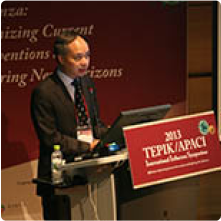
Professor Paul Chan.
Chair, Department of Microbiology, Faculty of Medicine, The Chinese University of Hong Kong, Hong Kong
Since 2012, the World Health Organization (WHO) has made recommendation for an additional influenza vaccine component to allow manufacturers to produce quadrivalent influenza vaccines. To provide contextual specific data to assess the need and the justification for increase in vaccination cost, a retrospective study was conducted to reveal the status of influenza B lineage circulation in a subtropical city, Hong Kong, over a period of 10 years.
Altogether, 268 influenza B isolates collected from patients hospitalized between 2000 and 2010 were examined. The sequence of a fragment of the haemagglutinin gene was used to determine the lineage based on phylogenetic analysis. Hospital records and population census data were used to estimate annual age-specific admission rates associated with influenza A and B, and their changes with lineage circulation pattern.
It was found that co-circulation with two lineages (Yamagata and Victoria) of influenza B viruses was very common and occurred in 9 of the 10 years. Only in 6 of the 10 years, had the influenza B lineage selected by WHO matched with the one contributed to a majority (50%) of the circulating pool. In predominated years (i.e. one of the influenza B lineages accounted for 80% of the circulating pool), higher hospitalization rate was observed. Unfortunately, only in 2 of these 6 predominated years, had the WHO selected lineage matched with the predominant one. The Yamagata lineage seemed to be more clinically important which accounted for most (5 of 6) of the predominated years. Overall, influenza B attributed to a substantial proportion (24%) of patients hospitalized for influenza, especially among children and young teenagers (41.9%).
In conclusion, co-circulation of influenza B lineages in subtropical region is common. The chance of predicting the next predominant lineage is not high. Quadrivalent vaccines including both lineages of influenza B may improve the effectiveness of vaccination program.
H7N9 Influenza Virus In China.

Dr Feng Luzhao.
Deputy Chief, Branch of Respiratory Infectious Diseases, Division of Infectious Diseases, Chinese Center for Disease Control and Prevention, China
On 31 March 2013, the public health authorities of China reported three cases of laboratory-confirmed human infection with avian influenza A(H7N9) virus (hereafter H7N9). By 29 May 2013, approximately 2 months after the initial report, the number of laboratory-confirmed H7N9 infections reached 132, with 40 deaths, originating from these locations and seven
additional provinces, Shandong, Zhejiang, Henan, Hunan, Fujian, Jiangxi, and Jiangsu, and the municipality of Beijing, in addition to one case reported by Taipei Centers for Disease Control (CDC) (with a history of recent travel from Jiangsu). The novel viruses are reassortants, comprising H7 HA, N9 NA and the six internal genes of H9N2 influenza A viruses. This combination of influenza genes has not previously been identified among viruses obtained from birds, humans or any other species, although individual genes are related to those of recent avian influenza viruses circulating in East Asia.
Most patients initially developed an influenza-like illness (ILI) that subsequently progressed to respiratory distress syndrome resulting in hospitalization. Of 123 patients with laboratory-confirmed avian influenza A H7N9 virus infection who were admitted to hospital, 37 (30%) had died and 69 (56%) had recovered by May 28, 2013. After we accounted for incomplete data for 17 patients who were still in hospital, we estimated the fatality risk for all ages to be 36% (95% CI 26–45) on admission to hospital. Risks of mechanical ventilation or fatality (69%, 95% CI 60–77) and of admission to an intensive care unit, mechanical ventilation, or fatality (83%, 76–90) were high. With assumptions about coverage of the sentinel surveillance network and health-care-seeking behaviour for patients with influenza-like illness associated with influenza A H7N9 virus infection, and pro-rata extrapolation, we estimated that the symptomatic case fatality risk could be between 160 (63–460) and 2800 (1000–9400) per 100 000 symptomatic cases(Yu et al. Lancet 2013). Of 130 people with laboratory confirmed A/H7N9 infection as of 27 May 2013, five (4%) were detected through the sentinel surveillance system for influenza-like illness. Only two of the five patients needed hospitalization, and all five had mild or moderate disease with an uneventful course of recovery (Dennis KM Ip et al. BMJ 2013). Underlying chronic conditions were reported in most cases. The median age of the 130 individuals with confirmed infection with H7N9 was 62 years and of the 43 with H5N1 was 26 years. In urban areas, 74% of cases of both viruses were in men, whereas in rural areas the proportions of the viruses in men were 62% for H7N9 and 33% for H5N1. 75% of patients infected with H7N9 and 71% of those with H5N1 reported recent exposure to poultry. The mean incubation period of H7N9 was 3·1 days and of H5N1 was 3·3 days. On average, 21 contacts were traced for each case of H7N9 in urban areas and 18 in rural areas, compared with 90 and 63 for H5N1. The fatality risk on admission to hospital was 36% (95% CI 26–45) for H7N9 and 70% (56–83%) for H5N1 (Cowling et al. Lancet 2013).
Investigations of H7N9 cases have so far revealed that except for four confirmed clusters of two or more cases that were in close contact, the patients did not appear to have known exposure to each other. However, most patients had a history of recent exposure to poultry, generally at live bird markets (Li et al. NEJM 2013, Chen et al. 2013). On April 5, 2013, the Ministry of Agriculture of China reported to the World Organization of Animal Health (OIE) the detection of low-pathogenic avian influenza A(H7N9) in a pigeon sampled at an agricultural wholesale market in the Shanghai municipality; this being the first H7N9 reported in birds in Asia since 2011 (OIE 2013b, Kageyama et al. 2013, Kim et al. 2012).
These preliminary studies suggested that despite numerous cases of H7N9 virus infection associated with poultry exposure, there is no evidence of sustained onwards virus transmission to other people (Li et al. 2013; Cowling et al. Lancet 2013). Human infections with avian influenza A H7N9 virus seem to be less serious than has been previously reported. Many mild cases might already have occurred. Continued vigilance and sustained intensive control efforts are needed to minimise the risk of human infection (Yu et al. Lancet 2013).
Development of New Diagnosis Systems for Detecting Influenza Viruses.
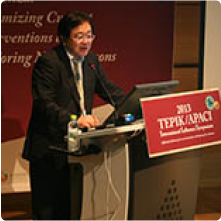
Dr Futoshi Shibasaki.
Head, Department of Genome Medicine/ Project Leader, Molecular Medicinal Research Project, Tokyo Metropolitan Institute of Medical Science, Japan
Influenza is a highly contagious disease caused by influenza viruses, and seasonal outbreaks of influenza virus are global health problem that causes substantial morbidity and economical loss. Highly pathogenic avian influenza (HPAI) viruses of the H5N1 strain pose a pandemic threat. Since 2003, HPAI H5N1 virus has widespread from Asian countries to
Europe and Africa, posing a great threat of the pandemic spread of high lethal contagious disease. A pandemic of swine-origin influenza virus (S-OIV) infection occurred in 2009. Finally, more than 214 countries were reported over 18,849 deaths by S-OIV infection, and WHO announced that the pandemic was moved into post-pandemic period at 10 September, 2010.
In 1997, an H5N1 outbreak with human cases of this extremely lethal and contagious disease occurred in Hong Kong. This event highlighted the need for rapid identification and subtyping of influenza viruses, not only to facilitate surveillance of the pandemic potential of avian influenza, but also to improve the control and treatment of infected patients. Molecular diagnosis has played a key role in the detection and typing of influenza viruses in recent years, spurred by rapid advances in the technologies for detection and characterization of viral RNAs and proteins.
Here, we established two diagnosis systems for detecting influenza viruses with developed technologies. (1) Super high-speed quantitative RT-PCR (Super Speed qRT-PCR) is a recently developed version of qRT-PCR that is characterized by extremely short reaction times (less than 15 min per run for 40 cycles). The rapid reaction time and high sensitivity of Super Speed qRT-PCR makes this technique well suited for monitoring epidemics and pre-pandemic influenza outbreaks. (2) The system Fluorescent immunochromatography (FLIC) is an improved immunochromatography (IC) using the antibody conjugated fluorescent beads instead of colloidal gold or HRP. The sensitivity of FLIC is several ten to over 100 times higher than that of previous IC methods for detecting seasonal A and B type influenza viruses. In addition, our newly generated (Pan-H5) antibodies against H5-HA proteins can react with all H5 subtypes of influenza viruses including Eurasian and North American H5 subtypes.
Our two new protocols are expected to provide new strategies for controlling the transmission of influenza viruses.
Impact of a Multiplexing Approach to testing and Screening for Clinical Management of Influenza and Respiratory Diseases.
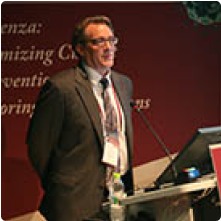
Dr David Lee Dolinger.
Executive Vice President, Seegene Inc., USA
Acute viral respiratory infections are a major concern when it comes to morbidity and mortality for all ages but especially for the young, the elderly and the immune-compromised. Viral causes have been shown to account for upwards of 80% of acute respiratory tract infections. Due to the overlap in patient presentation, it is particularly difficult to identify the causative agent based solely upon symptoms. In addition, outbreaks of acute respiratory infections have
been shown to strain the healthcare system. Therefore, rapid and accurate diagnosis and identification of the infectious agent is critical for proper patient management, reduction of nosocomial infections and epidemiological reporting and control. Tagging Oligonucleotide Cleavage ad Extension (TOCE™) is an innovative technology which allows the development of robust high-multiplex assays that are capable of being run on existing install base of real-time instruments. Utilizing this new chemistry, a panel which is capable of detecting and differentiating 16 etiological agents of viral respiratory infections has been developed. Tests such as the Anyplex™ II RV16 assay are now providing clinical laboratories with the tools for the diagnosis of viral respiratory infections but more importantly are providing clinician with valuable information for guiding patient care.
1. Chen JR, Ma C* Wong CH* (2011). Vaccine design of hemagglutinin glycoprotein against influenza. Trends in Biotechnology, 29, 426-434.
2. Wang CC, Chen JR, Tseng YC, Hsu CH, Hung YF, Chen SW, Chen CM, Khoo KH, Cheng TJ, Cheng YSE, Jan JT, Wu CY, Ma C* Wong CH* (2009). Glycans on influenza hemagglutinin affect receptor binding and immune response. Proc. Natl. Acad. Sci. U. S. A. 106, 18137-18142.

